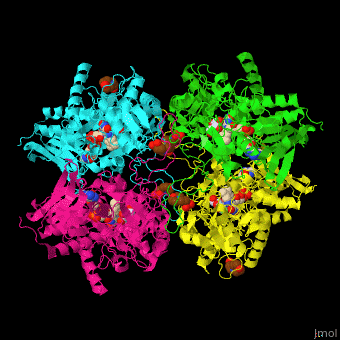Pyranose oxidase
From Proteopedia
FunctionPyranose oxidase or pyranose 2-oxidase (P2O) catalyzes the conversion of D-glucose and molecular oxygen to 2-dehydro-D-glucose and H2O2. It is abundant in lignin-degrading white rot fungi. P2O is a tetramer flavoprotein containing the prosthetic group FAD in each monomer. P2O oxidizes several aldopyranoses with the preferred electron donors being D-glucose, D-xylose and D-sorbose[1]. RelevanceConverting common sugars and sugar derivatives with P2O provides a pool of sugar-derived intermediates for the synthesis of rare sugars, fine chemicals and drugs. Structural highlightsThe active site of P2O is gated by a highly conserved loop which determines the substrate specificity. Water molecules are shown as red spheres. The active site contains the FAD cofactor[2]. |
| ||||||||||
3D Structures of pyranose oxidase
Updated on 21-August-2019
References
- ↑ Giffhorn F. Fungal pyranose oxidases: occurrence, properties and biotechnical applications in carbohydrate chemistry. Appl Microbiol Biotechnol. 2000 Dec;54(6):727-40. PMID:11152063
- ↑ Spadiut O, Tan TC, Pisanelli I, Haltrich D, Divne C. Importance of the gating segment in the substrate-recognition loop of pyranose 2-oxidase. FEBS J. 2010 Jul;277(13):2892-909. Epub 2010 Jun 2. PMID:20528921 doi:10.1111/j.1742-4658.2010.07705.x






